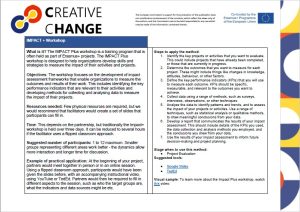Impact+ Workshop
| What is it? The IMPACT Plus workshop is a training program that is often held as part of Erasmus+ projects. The IMPACT Plus workshop is designed to help organizations develop skills and strategies to measure the impact of their activities and projects.
Objectives: The workshop focuses on the development of impact assessment frameworks that enable organizations to measure the outcomes and results of their work. This includes identifying the key performance indicators that are relevant to their activities and developing methods for collecting and analysing data to measure the impact of their projects. Resources needed: Few physical resources are required, but we would recommend that facilitators would create a set of slides that participants can fill in. Time: This depends on the partnership, but traditionally the Impact+ workshop is held over three days. It can be reduced to several hours if the facilitator uses a flipped classroom approach. Suggested number of participants: 1 to 12 maximum. Smaller groups representing different areas work better – the dynamics allow more interaction and longer time for discussion. Example of practical application: At the beginning of your project, partners would meet together in person or in an online session. Using a flipped classroom approach, participants would have been given the slides before, with an accompanying instructional video, using YouTube or TedEd. Partners would then be required to fill in different aspects to the session, such as who the target groups are, what the indicators and data sources might be etc. Steps to apply the method:
Stage when to use this method:
Suggested tools: Visual sample: To learn more about the Impact Plus workshop, watch this video: |


